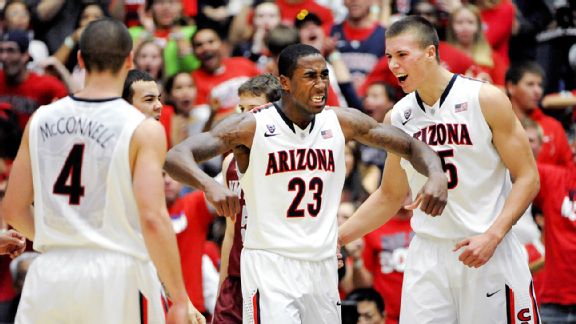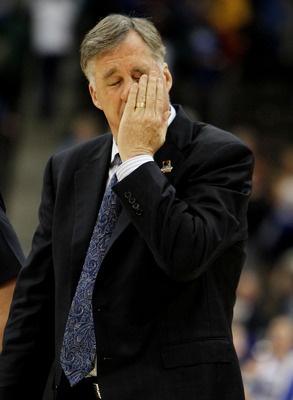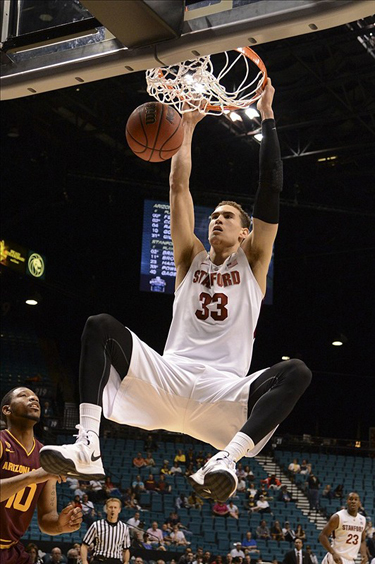Rounding Up Pac-12 Quarterfinal Thursday
Posted by Andrew Murawa on March 14th, 2014The big talk around the conference tournament on Wednesday was Utah’s potential. A KenPom darling ranked in the upper 30s by that metric with a history of playing everybody – including conference elite Arizona – tough, they were usually somewhere around the “Next Four Out” section of most bracketology projections. A win over Arizona in Thursday’s quarterfinal, and maybe they jump California for the seventh Pac-12 team in line for an NCAA bid. For the first segment of the game Thursday afternoon, things were fine, with the Wildcats holding a 7-6 lead at the under-16 timeout. And then. Well. Adjectives fail to adequately describe, so let’s jump right to the numbers: over the remainder of the half, Arizona outscored the Utes 27-6 and 44-11 over the next roughly 23 minutes of game time. At the half, Utah was averaging less than a point every two possessions (0.48 PPP). Arizona was grabbing 92.9% of defensive rebound opportunities and 53.8% on the offensive end. They were leading 8-0 in fast break points, 9-2 in points off turnovers and 16-8 in points in the paint. Three Utes scored in the first half, and their top-three leading scorers on the year – Delon Wright, Jordan Loveridge and Brendan Taylor – were not among them. We could go on.

Arizona’s Defensive Dominance Was Displayed Early and Often Thursday Afternoon (Casey Sapio, USA Today)
There are more stats to be spouted about how dominant the Wildcats were on Thursday afternoon, but there will be more opportunities for them to show off for the rest of the country. Put simply, if the Arizona team that showed up today, and that showed up a couple weeks back dominating the Bay Area schools, continues to be the default Wildcat team, they’ve got a very good chance of cutting down the nets in April. As for Utah, they’ll have an opportunity to continue their season in the NIT, and they’ll be a very tough out there. And next year, behind Wright and Loveridge, they’ll be a favorite for an upper-division Pac-12 finish and an NCAA Tournament invitation. Neither of those things, however, give them much solace now.
The second game of the day featured California and Colorado, two teams on the bubble, to one degree or another. The expectation was that Colorado was pretty safely in, while the Golden Bears would need to win this game to even have a chance. And so, when two Justin Cobbs jumpers in the final 30 seconds – each of which could have tied up the game – fell uncharacteristically short, the consensus seemed to be that Cal jumped up near the front of the early list of NIT candidates. Their resume at this point features a mediocre RPI (in the 50s somewhere, depending on how the day shakes out), a win over Arizona as their high point and solid wins over Colorado, Arkansas and a couple on the road at Oregon and Stanford. That makes for a more worthwhile set of accomplishments than teams like Arkansas or Green Bay. Further, go ahead and compare Cal’s resume to Iowa’s. There’s a little plus on one side, a little negative on the other, but they’re more or less equal. How about Providence? Cal’s slate looks better, right? Saint Joseph’s? Almost the exact same thing, right? BYU? Between all four of those bad losses and the unfortunate injury to Kyle Collinsworth, Cal’s got the better resume. And still, teams like Iowa and Providence and Saint Joe’s and BYU all seem to be ahead of the Golden Bears for some reason. Nevertheless, don’t be surprised if Cal still has a chance to hear its name called ahead of these teams on Selection Sunday.

Mike Montgomery and Cal Are Done At The Pac-12 Tournament, But May Still Have An Argument To Go Dancing (credit: Doug Benc)
Another point on this game that we can file in my personal crusade against bad end-of-game decision-making. With 1:40 remaining and Colorado up two, Askia Booker rebounded a missed Cobbs three. Booker walked the ball up court, held the ball for awhile and then called timeout with 19 seconds on the shotclock. After the timeout, apparently the plan was to inbound the ball to Booker, have him hold the ball until the end of the shotclock and then jack up a wild three, because that’s precisely what happened. The good news for Colorado was that they were able to secure the offensive rebound and earn a new 35 second shotclock. So, what did they do? Again, held the ball until the end of the shotclock (at least making a show of passing the ball around the perimeter) and this time settled for a Josh Scott jumper that cannot have been their ideal look and that did not go. What, in that situation, is the benefit of running the shotclock out and getting poor shots? Wouldn’t you rather have a four-point lead with, say 1:20 left than what they wound up with: a two-point lead with 23 seconds left?
So, now Colorado seemed to me at least to have run back-to-back possessions in precisely the way you should have run a late-game possession. What did Cal do when they had the ball down two with 23 seconds left? Got the ball in the hands of their best player, Cobbs, and got him a good, quick look at his preferred shot: a clean, mid-range step-back jumper. The shot didn’t go, but after Colorado earned possession, the Golden Bears still had plenty of time to play the foul-and-extend-the-game strategy. And it worked. They wound up with two possessions in the final 12 seconds, got a quick hoop from Cobbs to extend the game further, and then following a missed Colorado free throw (after three consecutive makes), they again got Cobbs a good look at a game-tying three at the buzzer. Again, that shot did not go, but Cal ran good offense that gave themselves the best chance to win the game and Colorado did not. The fact that Cal still lost the game is beside the point.
In the third quarterfinal, UCLA dispatched of Oregon with relative ease, using an 18-4 run out of the gates in the second half to put some distance between the two teams and never looking back. For the Bruins, it was a bounce-back game after an awful loss at Washington State in the regular season finale, while the Ducks had their eight-game win streak broken. But let’s not read too much into this, as the Bruins just aren’t a great matchup for the Ducks. Guards like Jonathan Loyd and Dominic Artis (and even Jason Calliste and Joseph Young) are just no match for UCLA’s bigger, more physical guards like Kyle Anderson, Jordan Adams and Norman Powell. And maybe worse yet, the Ducks don’t have the type of physical post presence that can really take advantage of the Wear twins in the middle. Throw in the fact that the Ducks were abnormally loose with the ball (17 turnovers) and errant from deep (8/26 from deep) and events conspired to create the 19-point loss. But Oregon should not necessarily be thought of any more warily today than they were yesterday. Likewise, this UCLA team is still a team without any really great wins on the year – their two wins over Oregon are probably the two best – and while there is plenty of talent here, consistency remains a question mark. For what it’s worth, UCLA head coach Steve Alford does know a thing or two about winning conference tournaments in Las Vegas, having led New Mexico to the Mountain West Tournament title the past two seasons.

Behind A Big Second Half From Dwight Powell, The Cardinal Removed All Doubt About Their NCAA Tournament Credentials (USA Today Sports)
In the nightcap, Johnny Dawkins and Stanford essentially clinched an NCAA Tournament invitation for the first time in the coach’s six seasons with the Cardinal. Dwight Powell and Chasson Randle had big second halves, combining for 27 points on nine-of-12 shooting from the field to break open what was a three-point game at the half en route to a 21-point win. Now, Stanford’s got an RPI in the upper 40s, a strength-of-schedule of 30, five wins against top 50 RPI teams and no bad (sub-101 RPI) losses. They’ve still got work to do in order to improve their potential seed, but with UCLA and potentially Arizona ahead, they’ll have opportunities to get good wins.
As for Arizona State, Thursday night is best forgotten. Bo Barnes and Jonathan Gilling kept the Sun Devils in the game in the first half with 20 points between them, but when that dried up, the Sun Devils’ key cogs were largely absent as Jahii Carson and Jermaine Marshall combined for just 14 points on 21 field goal attempts. Still, laying an egg like this in a tournament setting is unsettling; Sun Devils fans have to hope this was just an example of the team getting an awful effort out of their system, rather than a sign of things to come.










































